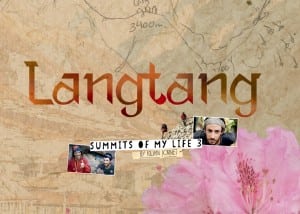 As part of his Summits of My Life project, Kilian Jornet intended to climb Mount Everest in Nepal in the spring of 2015. Filmmaker Sébastien Montaz-Rosset was to accompany and document the journey. As the team was getting ready to depart Europe, a devastating earthquake struck Nepal, killed thousands, and left a significant portion of the population without access to basic living supplies. Accordingly, it also closed down the 2015 Everest climbing season. In the days immediately following the quake, Kilian, Seb, and Jordi Tosas, Kilian’s friend and adventure partner who had previously visited Nepal more than two dozen times and who was to be the third member of the small Everest team, went to Nepal anyway, to see if and how they could help.
As part of his Summits of My Life project, Kilian Jornet intended to climb Mount Everest in Nepal in the spring of 2015. Filmmaker Sébastien Montaz-Rosset was to accompany and document the journey. As the team was getting ready to depart Europe, a devastating earthquake struck Nepal, killed thousands, and left a significant portion of the population without access to basic living supplies. Accordingly, it also closed down the 2015 Everest climbing season. In the days immediately following the quake, Kilian, Seb, and Jordi Tosas, Kilian’s friend and adventure partner who had previously visited Nepal more than two dozen times and who was to be the third member of the small Everest team, went to Nepal anyway, to see if and how they could help.
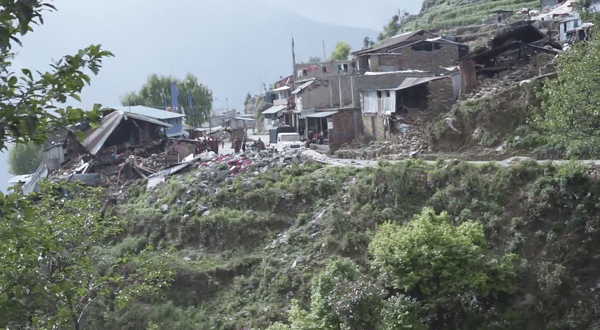
A village in lower Langtang Valley is one example of earthquake damage. All photos are screenshots from the film.
Langtang Valley, a remote, high valley not far to the northeast of Kathmandu, Nepal’s capital, suffered robust damage. The earthquake and its aftershocks shook the ground so hard that hundreds of structures collapsed and killed people inside of them. Major landslides and rockfalls destroyed many paths connecting villages within the valley and cut the valley off from the outside world. Those same slides killed many people traveling those paths.

A Langtang Valley resident tells the team about the family members he lost in the earthquake.
The greatest damage, however, occurred via a strange avalanche and wind event. Experts have determined that the earthquake caused high, hanging glaciers to dislodge and fall thousands of feet into Langtang Valley from mountains above. This instantly displaced air away from those massive, falling glacier pieces at speeds in excess of 90 miles per hour, carrying snow, ice, and rocks. This literally flattened Langtang Village, which is one of the valley’s villages, killing many and causing massive damage to the land surrounding the village. Jordi had many times visited Langtang Valley prior to this trip—including just two months before—and Kilian had been once before, too. The group seemed pulled into it by their already-established emotional connection. This film is largely about the team’s experience in that valley.
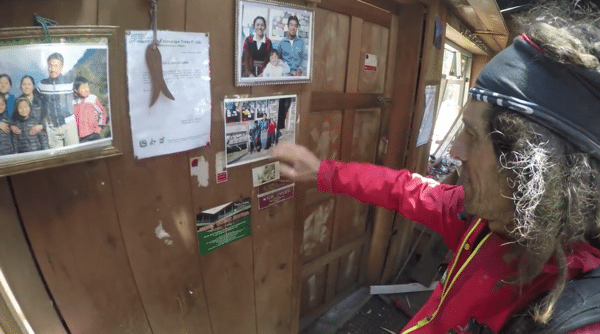
Jordi Tosas looks at pictures of people he knows in Langtang Valley.
Let me begin my review by saying that Langtang is neither an adventure film nor a typical Seb Montaz production. While we do see Kilian and company sprint around a couple of times, it’s only because they are scurrying across dangerous landslide zones or trying to make haste in running from village to village to pass along word of where and when outside aid is coming to the valley. The film is almost entirely lacking in the imposing and inspiring vista-scapes with which Seb typically fills his work. And the cinematography is simplified—even rushed and primitive in many places—and not representative of what Seb can and usually does. But it’s also important to note that none of this would be appropriate for what Kilian and company were experiencing and doing in Nepal, nor appropriate for what the film is about. I’m guessing that running and getting the light just right and setting certain camera angles might have been precisely the last things on the team’s mind during its three weeks in Nepal.

Kilian Jornet and Jordi Tosas look up at the peaks above Langtang Valley.
This film is different—very different—and so while it may be good to reset expectations of what you’re going to experience as you watch it, I’m certain you’ll find it well worth your time. It mourns Nepal’s death and destruction with a sadness and softness that you can tangibly grip on to, no matter how many thousands of miles from Nepal you are. You’ll marvel at the resiliency of the human species to emotionally survive such a replete form of tragedy. You’ll find the film informational about some of what was happening at the ground level in remote Nepal immediately after the earthquake. It carries a tension-filled storyline that you’ll want to see intellectually through. If proffers a piece of Kilian’s private life, which since he’s a global household name, will interest many. You’ll witness startling generosity demonstrated by the Nepali people amidst their own great loss, which should inspire many of us—who have infinitely more than these people—to be kinder to others.
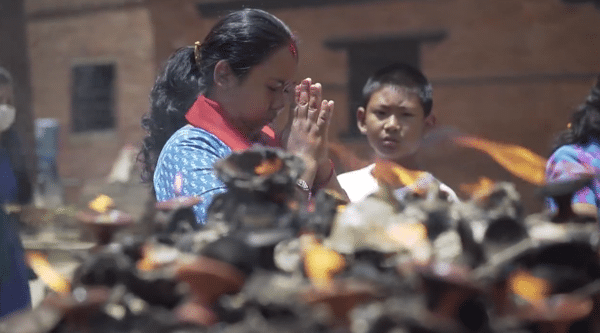
A woman prays in Kathmandu.
There’s a lot going on in the film, so much so that I needed to watch it twice to take in all the details. It is, however, these details that captivate the watcher and progress the storyline. A big aftershock rocks Kathmandu while the team is there, and there’s a torrid chase scene caught on film in which they are trying to get out of a rocking and shaking building and into the streets, a perceived safe zone. The scene is over and done in just a few seconds, but the shot of adrenaline it induces lasts a lot longer and makes you realize how frightening and destructive nature can be. There are some cuts of Nepali people praying—real ground-level, with-the-praying-people’s shots—and the juxtaposition of the peace and calm they clearly feel with the troubled mood of the film and what must have been the overall sentiment in Nepal is absolutely exquisite. And there’s a scene where the team is talking to a local man about the members of his family who he believes are dead as a result of the earthquake. We don’t know who he is or how many days after the quake this moment takes place or anything, really, about his story—but we still feel his wretched heartbreak.
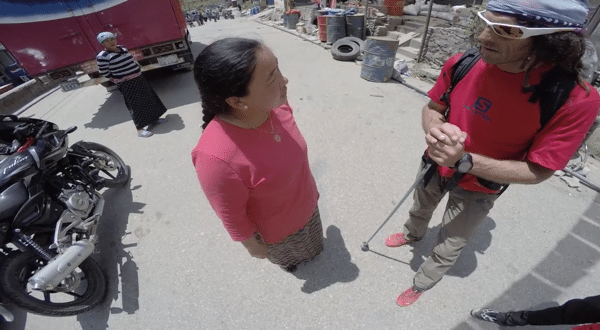
A woman asks the team to look for her family member who is missing in Langtang Valley.
I don’t love every moment of the film. There’s a strange dream sequence, which is supposed to remind viewers that Kilian’s Everest climb is part of his larger Summits of My Life project and show what not being able to climb Everest in 2015 means for Kilian’s bigger project picture. I found the sequence too juvenile in its telling and, really, rather unnecessary at all as this is a film about Nepal.
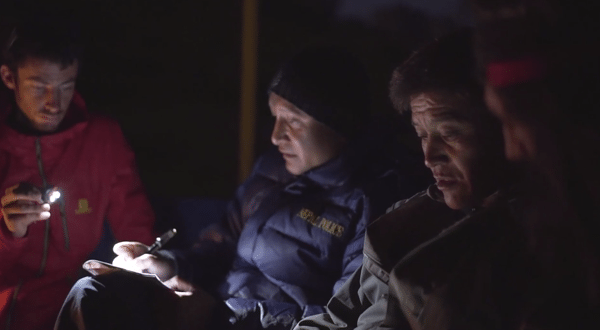
The army in Langtang Valley grants the team permission to help with surveying the valley post-earthquake.
The biggest gap I found was in the plot. Langtang Valley’s story is told through the eyes of Jordi and Kilian, largely through the filter of Jordi’s previous experience there. Indeed, Jordi has a long history with the valley and has friends he lost and who survived the earthquake. I enjoyed learning about his connection to the place. However, I wanted to know more about the valley itself, its people, its villages, its geography—and I found myself turning to Google for that information when the film didn’t provide it. I realize and certainly respect that immediately after the earthquake would not have been the time to gather oral histories, observe people’s lives, and capture images from high above that lend geographic perspective. Telling the valley’s greater story would have required a return visit to Nepal and much more time and expense. This might not have been possible, though it would have, in my mind, improved the film.

Kilian Jornet locating the bodies of locals and tourists who didn’t survive the earthquake in Langtang Valley.
So, here’s the crux (and perhaps the irony). The films we’ve seen of Kilian by Seb in the past have offered up an hour or so of just plain fabulous entertainment and a beautiful kick in the pants to get out the door and have our own adventures. Lots of time and money get spent making, if I can be perfectly honest, extraneous (but truly awesome) entertainment offerings. This film, simplified at almost every level, seeks an advanced goal, to raise money to rebuild more than 100 structures that were destroyed in Langtang Valley. Langtang does excellent work of bringing the story of Langtang Valley to us, wherever we are on earth, and motivating us to help that story have a future.
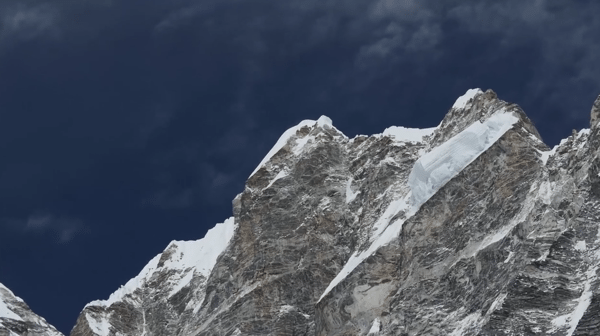
The high peaks above Langtang Valley from which glaciers fell during the earthquake.
[Editor’s Note: The Summits of My Life team wants to rebuild 116 houses in Langtang Valley. See their website for precise information on the amount of money needed and how to donate. ‘Langtang’ will be released to the public on Saturday, December 12, and you can pre-order and/or download on the project website.]
Traducción al Español — Review de Langtang
 Como parte de su proyecto Summits of My Life, Kilian Jornet tenía la intención de subir el Monte Everest en Nepal en la primavera del 2015. El productor de películas Sébastien Montaz-Rosset acompañaría y documentaría el viaje. Mientras el equipo se preparaba para dejar Europa, un devastador terremoto golpeó Nepal, dejando miles de muertos y a una significante porción de la población sin acceso a los elementos básicos necesarios para vivir. En consecuencia, también cerró la temporada 2015 de ascensos al Everest. Los días posteriores al terremoto, Kilian, Seb y Jordi Tosas, amigo de Kilian y compañero de aventuras quién visitó Nepal más de dos docenas de veces, y quién iba a ser el tercer miembro de la pequeña expedición al Everest, decidieron ir a Nepal igualmente para intentar ayudar.
Como parte de su proyecto Summits of My Life, Kilian Jornet tenía la intención de subir el Monte Everest en Nepal en la primavera del 2015. El productor de películas Sébastien Montaz-Rosset acompañaría y documentaría el viaje. Mientras el equipo se preparaba para dejar Europa, un devastador terremoto golpeó Nepal, dejando miles de muertos y a una significante porción de la población sin acceso a los elementos básicos necesarios para vivir. En consecuencia, también cerró la temporada 2015 de ascensos al Everest. Los días posteriores al terremoto, Kilian, Seb y Jordi Tosas, amigo de Kilian y compañero de aventuras quién visitó Nepal más de dos docenas de veces, y quién iba a ser el tercer miembro de la pequeña expedición al Everest, decidieron ir a Nepal igualmente para intentar ayudar.
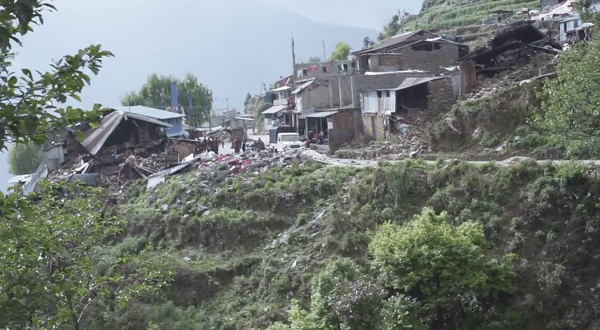
Aldea en el bajo del Valle de Langtang, ejemplo del daño provocado por el terremoto. Todas las fotos son capturas de pantalla de la película.
El Valle de Langtang, un remoto valle de altura no muy alejado al noreste de la capital de Nepal, Kathmandú, sufrió daños devastadores. El terremoto y sus réplicas fueron tan fuertes que cientos de edificios colapsaron, y mataron a las personas dentro de ellas. Los caminos que conectan las aldeas se vieron destruidos por los grandes desprendimientos de tierras y caídas de rocas, como también dejaron incomunicado al valle con el resto del mundo. Los mismos desprendimientos dejaron como víctimas fatales a quiénes transitaban esos caminos.
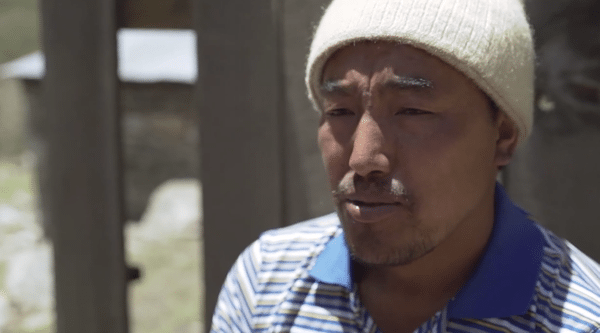
Un residente del Valle de Langtang cuenta al equipo sobre los miembros de su familia fallecidos en el terremoto.
Sin embargo, el daño más grande ocurrió debido a un fenómeno de viento y avalanchas. Los expertos determinaron que el terremoto causo desprendimientos en glaciares ubicados en las alturas de las montañas aledañas al Valle de Langtang, haciéndolos caer cientos de metros. Esto provocó un desplazamiento instantáneo de aire desde esos enormes, gigantes trozos de glaciar a velocidades que superaban los 140 kilómetros por hora, trayendo consigo nieve, hielo y rocas. Esto dejó a la Aldea de Langtang literalmente aplanada, que es una de las aldeas dentro del valle, matando a muchos y causando daños extremos a las tierras alrededor de ella. Jordi visitó el Valle de Langtang varias veces antes de este viaje –dos meses antes fue el último- y Kilian estuvo allí una vez, también. El grupo se vio impulsado por su conexión emocional con el lugar. Esta película trata, en su mayoría, sobre la experiencia del grupo en el Valle.
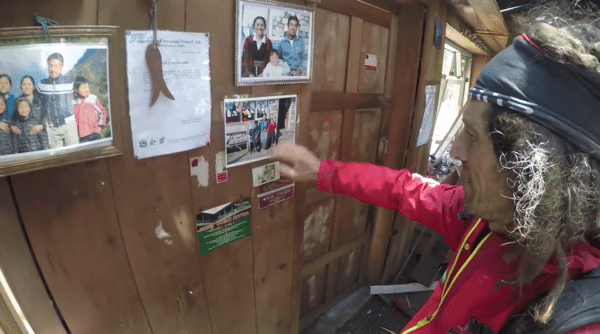
Jordi Tosas observa fotografías de gente que conoce en el Valle de Langtang.
Permítanme comenzar mi análisis diciendo que Langtang no es una película de aventura, ni tampoco una producción típica de las de Seb Montaz. Si veremos a Kilian y compañía corriendo algunas veces, será solo porque están moviéndose por zonas peligrosas de derrumbes, o apresurándose para ir de una aldea a la otra comunicando cuando o donde vendrá el auxilio desde afuera al valle. La película escasea casi en su totalidad de los paisajes imponentes e inspiradores con los cuales Seb trabaja típicamente. Y la cinematografía esta simplificada –incluso apresurada y básica en varias partes- y no es representativa de lo que Seb puede hacer, y usualmente hace. Pero es importante destacar que nada de esto sería apropiado ni acorde a lo que Kilian y compañía estaban realizando y experienciando en Nepal, ni para la trama de la película. Supongo que correr y obtener el mejor ángulo, o la mejor luz, eran precisamente la última cosa que cruzaría por la mente del equipo durante sus tres semanas en Nepal.
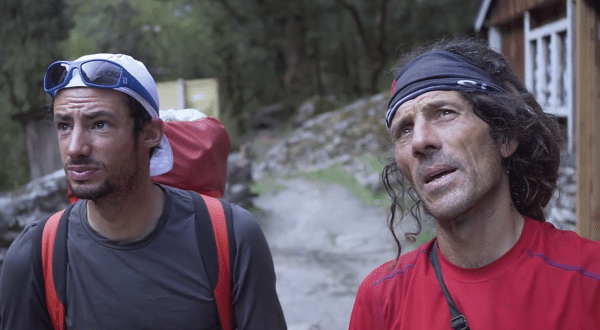
Kilian Jornet y Jordi Tosas observan las montañas sobre el Valle de Langtang.
Esta película es diferente –muy diferente- y si bien sería bueno que reseteen sus expectativas de lo que van a vivir cuando la vean, estoy segura que merecerá la pena invertir su tiempo en ella. Lamenta las muertes y destrucción en Nepal con una tristeza y ternura tangible, a la cual puedes aferrarte fácilmente, no importa a cuantos miles de kilómetros te encuentres de Nepal. Te maravillaras ante la resiliencia de la raza humana para sobrevivir emocionalmente a una tragedia tan grande. Encontrarás la película informativa respecto a lo que sucedía a nivel terrenal en Nepal inmediatamente después del terremoto. Lleva una trama cargada de tensión que querrás ver desarrollar intelectualmente. Muestra una porción de la vida privada de Kilian, que al ser un personaje de renombre global, generará interés en muchos. Serán testigos de la asombrosa generosidad de los Nepalíes en medio de su gran perdida, que debería inspirarnos a muchos –que tenemos infinitamente más cosas que ellos- a ser más amables con los demás.
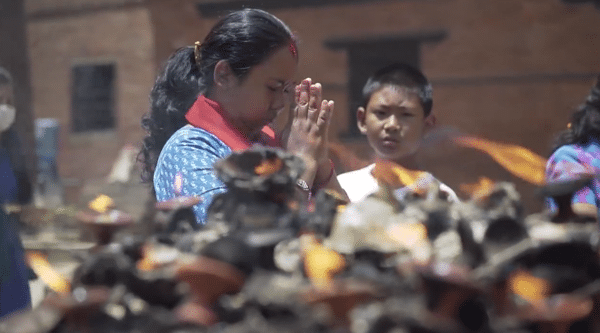
Una mujer reza en Kathmandú.
Suceden muchas cosas en la película, tantas que tuve que verla dos veces para captar todos los detalles. Sin embargo, son estos detalles que cautivan al espectador y llevan la trama. Una fuerte replica sacude Kathmandú mientras el equipo está allí, y hay una frenética escena captada por la cámara en la que tratan de escapar de un edificio en pleno terremoto a las calles, a una supuesta zona segura. La escena termina en un par de segundos, pero el golpe de adrenalina que induce dura mucho tiempo, y hace dar cuenta al espectador lo aterradora y destructiva que puede ser la naturaleza. Tiene escenas de gente Nepalí rezando – algo que hace poner los pies en la tierra – y la yuxtaposición de la paz y la calma que claramente sienten con el ánimo problemático de la película y lo que debe haber sido el sentimiento general en Nepal, es absolutamente exquisita. Y hay una escena donde el equipo habla con un hombre local sobre los miembros de su familia que él cree muertos como resultado del terremoto. No sabemos quién es, o cuantos días después del terremoto transcurre este momento, ni nada sobre su historia – pero todavía sentimos su corazón destrozado.
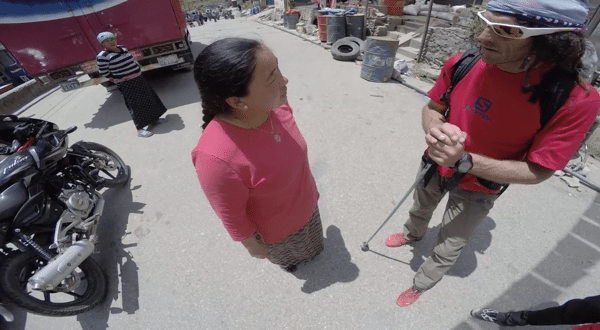
Una mujer pide al equipo que busque a su familiar desaparecido en el Valle de Langtang.
No me encanto cada momento de la película. Hay una secuencia extraña sobre un sueño, que pretende recordar al espectador que el ascenso al Everest de Kilian es parte de su amplio proyecto Summits of My Life, mostrando lo que significa no poder subir al Everest en 2015 en su imagen general del proyecto. Encontré a esta secuencia muy juvenil y más bien innecesaria ya que esta película es sobre Nepal.
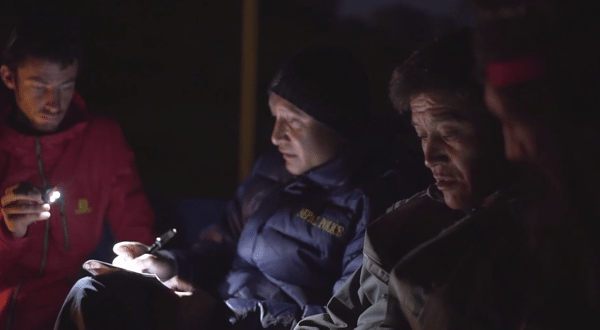
Un militar da permiso al equipo para ayudar en el Valle post-terremoto.
La mayor brecha la encontré en el argumento. La historia del Valle de Langtang está contada a través de los ojos de Jordi y Kilian, en su mayoría con el filtro de la experiencia previa de Jordi allí. De hecho, Jordi tiene una larga historia con el valle, y tiene amigos que fallecieron y otros que sobrevivieron al terremoto. Disfrute saber de su conexión con el lugar. No obstante, me gustaría saber más sobre el valle en sí, su gente, sus aldeas, su geografía –y me encontré Googleando esa información que la película no proporcionaría. Si entiendo y ciertamente respeto que inmediatamente después del terremoto no era el momento para reunir testimonios, u observar la vida cotidiana, o capturar imágenes desde las alturas que den perspectiva geográfica. Contar la historia general del valle hubiese requerido una segunda visita a Nepal, mucho más tiempo y dinero. Esto puede no haber sido posible, aunque hubiera, desde mi punto de vista, mejorado la película.
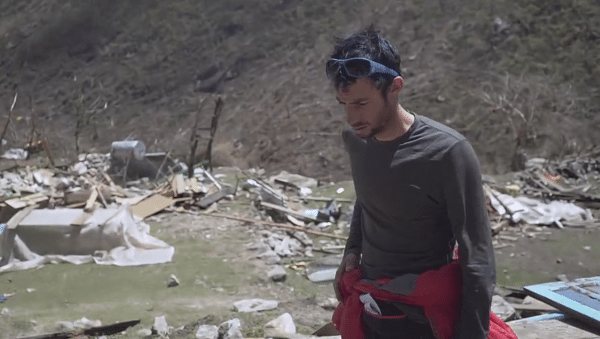
Kilian Jornet localizando los cuerpos de locales y turistas que no sobrevivieron al terremoto en el Valle de Langtang.
Ahora, aquí el quid (y quizás la ironía) de la cuestión. Las películas que hemos visto de Kilian hechas por Seb antes ofrecen una hora o más de entretenimiento fabuloso e increíbles impulsos a salir de casa y crear nuestras propias aventuras. Gastamos mucho tiempo y dinero, siendo perfectamente honesta, haciendo propuestas extrañas (pero verdaderamente increíbles) de entretenimiento. Esta película, simplificada en casi todos sus puntos, tiene un objetivo muy superior que es reconstruir más de 100 estructuras que fueron destruidas en el Valle de Langtang. Langtang hace a la perfección el trabajo de traernos la historia del Valle de Langtang a nosotros, donde sea que estemos en la tierra, y motivándonos a ayudar a que esa historia tenga un futuro.
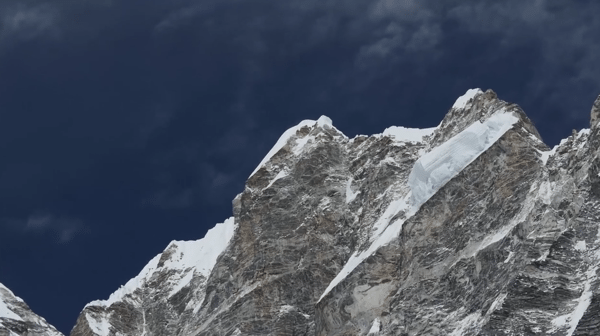
Los grandes picos sobre el Valle de Langtang, desde donde cayeron los glaciares durante el terremoto.
